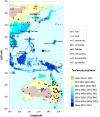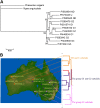Genetic Diversity and Phylogenetic Relationships of Annual and Perennial Glycine Species
- PMID: 31097479
- PMCID: PMC6643897
- DOI: 10.1534/g3.119.400220
Genetic Diversity and Phylogenetic Relationships of Annual and Perennial Glycine Species
Abstract
We have estimated the average genetic diversity of two Glycine annual and six perennial species based upon 76 orthologous gene sets and performed phylogenetic analysis, divergence analysis and tests for departure from neutrality of the eight species using 52 orthologous gene sets. In addition, 367 orthologous gene sets were used to estimate the relationships of 11 G. canescens accessions. Among the perennials, G. canescens showed the highest nucleotide diversity. The other perennials, except for G. tomentella, had higher nucleotide diversity than the two annuals. Phylogenetic analysis of the Glycine showed a similar genome grouping with the previous report except for G. cyrtoloba and G. stenophita which formed a sister clade in the study. Divergence analysis supported the phylogenetic relationships that G. falcata was the most divergent from G. max, followed by G. cyrtoloba, G. syndetika, G. tomentella D3, G. stenophita and G. canescens Most genic sequences were homogeneous in the levels of polymorphism and divergence between G. max and other Glycine species based on the HKA test, thus, Glycine perennials may have experienced a very similar evolution as inferred by trans-specific mutation analysis. The greater genetic diversity of most perennial Glycine species and their origins from the warmer and drier climates of Australia suggests the perennials maybe a potential source of heat and drought resistance that will be of value in the face of climate change.
Keywords: divergence; nucleotide diversity; perennial crop relatives; phylogenetic analysis; soybean; trans-specific polymorphism.
Copyright © 2019 Hwang et al.
Figures





References
-
- Barker, D. G., T. Pfaff, D. Moreau, E. Groves, S. Ruffel et al., 2006 Growing M. truncatula: choice of substrates and growth conditions. Medicago truncatula handbook. Retrieved from https://www.noble.org/Global/medicagohandbook/pdf/GrowingMedicagotruncat....
-
- Bauer S., Hymowitz T., Noel G., 2007. Soybean cyst nematode resistance derived from Glycine tomentella in amphiploid (G. max X G. tomentella) hybrid lines. Nematropica 37: 277–286.
-
- Bodanese-Zanettini M. H., Lauxen M. S., Richter S.N.C., Cavalli-Molina S., Lange C. E., et al. , 1996. Wide hybridization between Brazilian soybean cultivars and wild perennial relatives. Theor. Appl. Genet. 93: 703–709. - PubMed
-
- Broué P., Douglass J., Grace J. P., Marshall D. R., 1982. Interspecific hybridisation of soybeans and perennial Glycine species indigenous to Australia via embryo culture. Euphytica 31: 715–724. 10.1007/BF00039210 - DOI
Publication types
MeSH terms
LinkOut - more resources
Full Text Sources
Other Literature Sources
